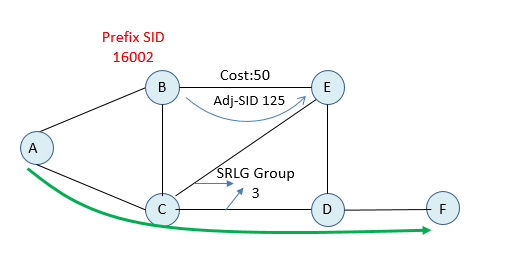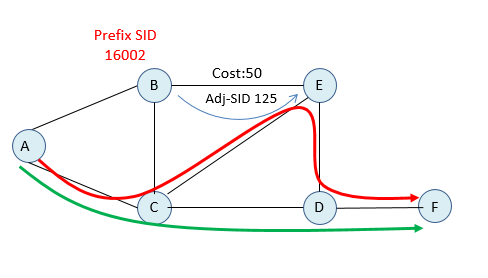TI-LFA also takes into account is SRLG exist in the network. Shared Risk Link Group (SRLG) is a set of links at the same risk of faults. If a link in an SRLG fails, other links also fail. In this case, if the other link in the SRLG functions as FRR backup to protect the failed link, protection does not take effect. SRLG is a link attribute, in numerical notation. The links with the same SRLG value are in one SRLG.
According to below topology, link between Node-C to Node-E and Node-C to Node-D have the same SRLG numeric value configured. It is assumed that they share the same transmission resource. All the links have a cost value of 1 except the link between Node-B and Node-E which is 50.

If we there wasn’t SRLG configuration, we could say, the backup path will be Node-A-Node-C-Node-E-Node-D-Node-F. But according to our assumption, if the link between Node-C and Node-D fails also link between Node-C and Node-E will fail. (SRLG configuration will be distributed by IGP as a part of SR extension)
Without SRLG (Red line is the backup path)

With SRLG; TI-LFA will solve this by adding the path which is not part of SRLG.
Incoming Active Segment: NULL Operation: PUSH 16006 (Prefix-SID of Node-F) Egress Interface: The interface towards to Node-C TI-LFA Backup: PUSH (16006,125) Interface towards to Node-B (PHP is enabled and 16002 is not part of label stack)

IP FRR, Remote LFA and MPLS TE FRR are highly used in current networks to provide link or node protection. They can provide the desired protection switching only if the topology and cost design allows you to do. Based on the Segment Routing technology, combined with the RLFA (Remote Loop-free Alternate) FRR algorithm, an efficient TI-LFA FRR algorithm is formed. TI-LFA FRR supports node and link protection of any topology and overcomes drawbacks in conventional tunnel protection.